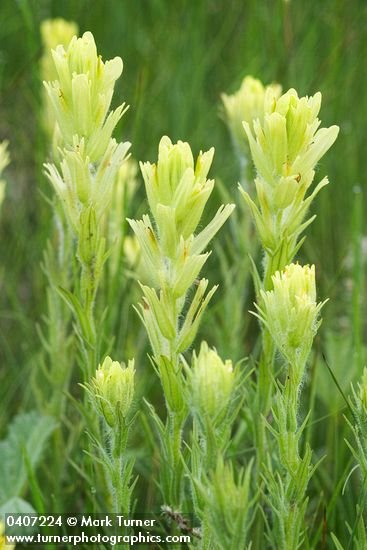Cusick's Indian Paintbrush
Castilleja cusickii
zones 3-7
100 seeds
Castilleja (Indian Paintbrush) is a very large genus with many species that are notorious for cross-pollinating and hybridizing. Since our seed is foraged from the wild, we can’t guarantee that the seed will produce the same flower as the parent plant.
This clumping species is covered with very small hairs, and its many stems are unbranched. It grows from 8-20” tall. The leaves are numerous, upward-pointing, and lance-shaped, with 3-7 slender lobes. What are commonly referred to as “flowers” are actually upper leaves. These bright-yellow bracts, its preference for moist, mucky meadows, and its clustering habit make this variety fairly easy to identify in the large family of Paintbrush species. True flowers are contained within the bracts and are not showy.
Paintbrushes are known as facultative parasites. Though they can survive on their own, they will sometimes parasitize the roots of other plants (especially sagebrush, penstemon, and bluestem). The parasitic relationship gives the Paintbrush greater access to water and nutrients, and does not appear to harm the host plant. If you have difficulty getting Indian Paintbrush to establish, try planting it with one of its preferred host plants.
Seeds are best sown in early autumn directly outdoors into garden of fine, well-drained soil. The minute seed should be mixed with potting soil, then broadcast onto the prepared area and gently water in. Stored seeds will need cold stratification for 3-4 months and sown as early as possible in the spring. Germination, especially of stored seed, is slow. Plants will not flower until the second or third year.
Castilleja cusickii
zones 3-7
100 seeds
Castilleja (Indian Paintbrush) is a very large genus with many species that are notorious for cross-pollinating and hybridizing. Since our seed is foraged from the wild, we can’t guarantee that the seed will produce the same flower as the parent plant.
This clumping species is covered with very small hairs, and its many stems are unbranched. It grows from 8-20” tall. The leaves are numerous, upward-pointing, and lance-shaped, with 3-7 slender lobes. What are commonly referred to as “flowers” are actually upper leaves. These bright-yellow bracts, its preference for moist, mucky meadows, and its clustering habit make this variety fairly easy to identify in the large family of Paintbrush species. True flowers are contained within the bracts and are not showy.
Paintbrushes are known as facultative parasites. Though they can survive on their own, they will sometimes parasitize the roots of other plants (especially sagebrush, penstemon, and bluestem). The parasitic relationship gives the Paintbrush greater access to water and nutrients, and does not appear to harm the host plant. If you have difficulty getting Indian Paintbrush to establish, try planting it with one of its preferred host plants.
Seeds are best sown in early autumn directly outdoors into garden of fine, well-drained soil. The minute seed should be mixed with potting soil, then broadcast onto the prepared area and gently water in. Stored seeds will need cold stratification for 3-4 months and sown as early as possible in the spring. Germination, especially of stored seed, is slow. Plants will not flower until the second or third year.
Castilleja cusickii
zones 3-7
100 seeds
Castilleja (Indian Paintbrush) is a very large genus with many species that are notorious for cross-pollinating and hybridizing. Since our seed is foraged from the wild, we can’t guarantee that the seed will produce the same flower as the parent plant.
This clumping species is covered with very small hairs, and its many stems are unbranched. It grows from 8-20” tall. The leaves are numerous, upward-pointing, and lance-shaped, with 3-7 slender lobes. What are commonly referred to as “flowers” are actually upper leaves. These bright-yellow bracts, its preference for moist, mucky meadows, and its clustering habit make this variety fairly easy to identify in the large family of Paintbrush species. True flowers are contained within the bracts and are not showy.
Paintbrushes are known as facultative parasites. Though they can survive on their own, they will sometimes parasitize the roots of other plants (especially sagebrush, penstemon, and bluestem). The parasitic relationship gives the Paintbrush greater access to water and nutrients, and does not appear to harm the host plant. If you have difficulty getting Indian Paintbrush to establish, try planting it with one of its preferred host plants.
Seeds are best sown in early autumn directly outdoors into garden of fine, well-drained soil. The minute seed should be mixed with potting soil, then broadcast onto the prepared area and gently water in. Stored seeds will need cold stratification for 3-4 months and sown as early as possible in the spring. Germination, especially of stored seed, is slow. Plants will not flower until the second or third year.
